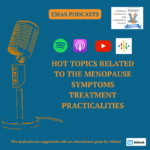Host: Welcome to today’s podcast. Practicalities: How to manage and schedule bleeding. This episode is part of a podcast series supported by Abbott. The content is solely the responsibility of EMAS, the European Menopause and Andropause Society. All our episodes are available in English, Spanish, Mandarin, and Russian, and you can find them on any of the most popular podcast platforms.
In today’s episode, Dr. George Kanakis, Consultant and Endocrinologist at the Naval Hospital of Athens and the Assisted Reproduction Unit of the Greek Armed Forces, Athens, Greece, will help us understand the significance of unscheduled bleeding and the peculiarities of its management during the perimenopausal period.
Dr. George Kanakis: Unscheduled bleeding is vaginal bleeding which occurs outside the normal menstrual period or the expected withdrawal bleed associated with cyclic hormone replacement therapy. This is a common condition in women of reproductive age and accounts for 20% of referrals to gynecological outpatient clinics while this figure falls to 5% among menopausal women.
Accordingly, the cause and its significance vary with age. In women younger than 35 years old, it is often related to contraceptive use and ovulatory dysfunction. On the other hand, as a woman enter the menopausal transition, they may face menstrual irregularities due to hormonal fluctuations, whereas in women with established menopause, the most frequent cause is vaginal or endometrial atrophy. Remarkably, in perimenopausal women, we should not miss possible organic causes, since the likelihood of uterine fibroids, polyps, and cervical or endometrial cancer increases with age.
Hormone replacement therapy may also be associated with unscheduled bleeding. Cyclic combined hormone regimens are characterized by regular monthly withdrawal bleeding, while the majority of women receiving continuous estrogen-progestin therapy will experience amenorrhea. However, up to a quarter of these women may present irregular bleeding, particularly during the first 6 months of therapy. Tibolone has also been commonly associated with irregular bleeding. Therefore, its use is not recommended until 12 months after the last natural period.
If a woman over 45 years of age who is on hormone therapy presents persistent unscheduled bleeding for more than 6 months, or bleeding which arises “de novo” after 6 months of therapy, or finally, bleeding refractory to proper modifications of the hormonal regimen, then she should undergo an endometrial biopsy to rule out neoplasia.
This applies also to all women who present bleeding after a period of established amenorrhea and who don’t receive exogenous hormones, particularly those with risk factors for endometrial cancer such as a history of menstrual irregularities, obesity and insulin resistance, chronic hypertension and use of tamoxifen. Keep in mind that the unscheduled bleeding may also be the result of an infection and especially of sexually transmitted origin.
The diagnostic workup should aim to identify any underlying pathology that is modifiable or life-threatening. For instance, signs such as obesity, hirsutism, galactorrhea, and goiter are indicative of endocrinopathies that need to be ruled out.
Physical examination may reveal the presence of a palpable abdominal mass which may be further clarified by transvaginal ultrasound. Speculum examination is also very important as it is capable of detecting invasive lesions of the cervix, while the presence of vaginal discharge is suggestive of an infection of the pelvis. Hysteroscopy may be required if intra-cavity disease is suspected. A pap smear should always be updated.
The management of unscheduled bleeding depends on the underlying cause and the severity of bleeding, and aims to control and prevent recurrent bleeding aside from correcting possible pathologists. Heavy bleeding, which may compromise the patient’s hemodynamic stability, needs hospitalization and intravenous administration of estrogens, additionally to fluids or transfusion. In cases of less severe bleeding, high doses of oral estradiol are given for up to 3 to 4 days which are gradually decreased as soon as bleeding is controlled. If estrogens are contraindicated, high progestogen doses are indicated. The above regimens may be supported by administration of tranexamic acid. If bleeding is not controlled by medical means, a dilation and curettage is indicated. Moreover, the patient should be checked for iron deficiency anemia and receive treatment as needed.
In perimenopausal women with irregular breeding, after the exclusion of organic causes, hormonal manipulations are indicated. Depending on the residual activity of the ovaries and the individualized preferences of the woman, the available options are cyclic progestin therapy, a progestin-secreting intrauterine device, cyclic or continuous combined hormone therapy, or finally, low-dose oral contraceptives. Non-steroidal anti-inflammatory drugs may also help reduce the duration of bleeding and cramping. If bleeding is due to exogenous hormonal therapy, increasing the dose of estrogen or progestogen may help.
Unscheduled bleeding may also be associated with the presence of fibroids. In particular, those of submucosal localization which may erode the overlying endometrium. Bleeding from fibroids may be relieved with constant progestin exposure obtained either orally or by an intrauterine system. If this approach is not successful, GnRH agonists or antagonists are used to induce estrogen deprivation. Larger tumors not responsive to medical treatment may need more invasive procedures such as embolization, surgical resection, or in women who do not desire future pregnancy, hysterectomy.
Regarding endometrial polyps, they usually produce light intermenstrual bleeding, and in the vast majority, they are benign. However, their malignant potential increases with age, therefore, in menopausal women, it is prudent to remove them upon diagnosis.
In general, women with findings suggestive of malignancies should be referred for further evaluation to oncology specialists.
In conclusion, unscheduled bleeding is a bothersome symptom for women which may either rise concerns for malignancy or be the reason for discontinuing otherwise beneficial hormone therapies. It is important, therefore, to get proper consultation from a healthcare provider to determine the appropriate management strategy based on the underlying causes and individual preferences.
Host: Today, Dr. George Kanakis discussed the significance of unscheduled bleeding and its management during the perimenopausal period. Thank you for listening to today’s episode. We hope it will be valuable for your clinical and research practice. Stay safe.
[END]


